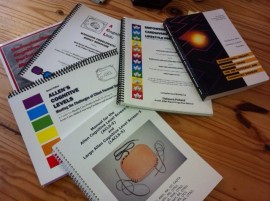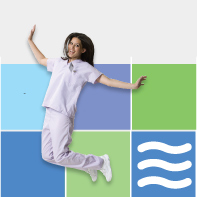 In the United States, dementia is the most common diagnosis for nursing home residents, and the prevalence of dementia may be as high as 74 percent in nursing homes (Magaziner et al., 2000). You may have seen the statistic that 5.4 million Americans have Alzheimer’s dementia (Alzheimer’s Association, 2011), but did you know that another 5.4 million Americans over the age of 70 have cognitive impairment without dementia (Plassman et al., 2008)?
In the United States, dementia is the most common diagnosis for nursing home residents, and the prevalence of dementia may be as high as 74 percent in nursing homes (Magaziner et al., 2000). You may have seen the statistic that 5.4 million Americans have Alzheimer’s dementia (Alzheimer’s Association, 2011), but did you know that another 5.4 million Americans over the age of 70 have cognitive impairment without dementia (Plassman et al., 2008)?
Ensign’s E-Prize
For those of you following the E-Prize competition, you may have noticed that two of the nine finalists in this contest specifically looked at improving the lives of residents with cognitive impairments. The facilities were Julia Temple and Holladay Healthcare, and the programs both facilities implemented were based on an Allen-Cognitive approach to care. Allen’s Cognitive Disability Model provides tools to evaluate the functional cognitive level of residents and gives you information on how to best interact with residents at different cognitive levels.
Evidence-Based Practice
The staffs of Julia Temple and Holladay Healthcare and the E-Prize judges agree that the Allen-Cognitive approach to caring for our residents improved their quality of life. We also have statistically significant results to support these observations. For my dissertation, I studied the effect of the Integrated Cognitive Program at Holladay Healthcare. The study looked at a group of 31 residents who lived at Holladay for the year before and 11 months after the implementation of the Allen-Cognitive approach to care. The study looked to see if implementation of the Allen-Cognitive approach had a measureable effect on the quality indicators of each resident. For the residents included in the study, quality indicators for three three-month periods before the implementation of the Allen-Cognitive approach were compared to quality indicators for three three-month periods post-implementation.
The residents in the study all had cognitive impairments — their level of impairment ranging from mild to severe on the MDS Cognitive Performance Scale. The study found a statistically significant reduction in the number of quality indicators for behavioral symptoms affecting others, and also a statistically significant reduction of total number of quality indicators for residents with an average of more than two quality indicators before the implementation of the program. These results suggest that an Allen-Cognitive approach can significantly improve the quality of care in nursing homes.
So how does the Allen-Cognitive approach work? The cognitive disabilities model presents six levels of cognitive abilities known as the Allen-Cognitive levels. Each level identifies the functional ability of a person, the scope of the person’s social ability and how much assistance the person needs to complete specific activities of daily living. The range of functional cognition covered in the Allen-Cognitive scale is from Level 1: profoundly disabled to Level 6: normative behavior. Each Allen level also is divided into five more specific levels called modes.
The Allen-Cognitive levels differ from most cognitive evaluations in that they measure functional cognition rather than verbal performance. The resident being assessed performs a task, and the therapist observes the sensory cues to which the client responds as well as the client’s motor actions during the task. At the lower end of the Allen-Cognitive scale, a person can respond only to internal cues and has only reflexive movements; at higher levels of cognition, a person can process more external cues and has purposeful movements.
Once we establish the resident’s Allen-Cognitive level, we can educate caregivers and family members on the abilities of the resident, allowing the caregivers to better understand and care for the resident. Allen refers to this as providing the person who has cognitive deficits with their “best ability to function.” By understanding the functional cognitive level at which a person is operating, we are able to provide cues that can mitigate the anxiety and frustration a person might experience when presented with a task that is too complicated for his or her remaining cognitive abilities.
Establishing a resident’s Allen-Cognitive level also allows us to identify excess disability based on the resident’s functional cognitive level. For example, a resident with an Allen-Cognitive level of 2.4 or higher has the functional cognitive ability to walk. Therefore, a resident with an Allen score of 2.4 or higher who is not walking and does not have a medical issue that precludes the ability to walk has the potential to walk. The fact that the resident is not walking is a disability in excess of the resident’s physical and cognitive conditions and may be improved with the intervention of a physical therapist. The physical therapist can use the Allen information to individualize treatment plans, set appropriate goals and justify the necessity of skilled services.
Several therapists who are skilled in the Allen assessments work for Ensign-affiliated operations and can be resources to you. There are also many books and continuing education classes available for the Allen-Cognitive approach. We encourage you to consider adopting this approach in your facility.
References:
Alzheimer’s Association. (2011). Alzheimer’s disease facts and figures. Alzheimer’s & Dementia, 7(2). Retrieved from: http://www.alz.org/downloads/Facts_Figures_2011.pdf
Magaziner, J., German, P., Zimmerman, S. I., Hebel, J. R., Burton, L., Gruber-Baldini, A. L., . . . Kittner, S. (2000). The prevalence of dementia in a statewide sample of new nursing home admissions aged 65 and older. The Gerontologist, 40(6), 663-672.
Plassman, B. L., Langa, K. M., Fisher, G. G., Heeringa, S. G., Weir, D. R., Ofstedal, M. B., . . . Rodgers, W. L. (2008). Prevalence of cognitive impairment without dementia in the United States. Annals of Internal Medicine, 148(6), 427-434.
 by Rhianna Wagers-Hughes PT, DPT, CEEAA, CSST and future CKTP –Kinesiotaping became popular during the 2008 Beijing Olympics when Kerri Walsh of the U.S. Beach Volleyball Team utilized kinesiotape to her right shoulder during the games. I was interested in learning a new taping method for my geriatric patients in the skilled nursing setting due to what I had read about the benefits of the tape. Kinesiotape is used to facilitate the body’s natural healing process while providing support and stability to muscles and joints without restricting the body’s range of motion as well as providing extended soft tissue manipulation to prolong the benefits of manual therapy administered within the clinical setting. Latex-free and wearable for days at a time, Kinesio® Tex Tape is safe for populations ranging from pediatric to geriatric, and successfully treats a variety of orthopedic, neuromuscular, neurological and other medical conditions.
by Rhianna Wagers-Hughes PT, DPT, CEEAA, CSST and future CKTP –Kinesiotaping became popular during the 2008 Beijing Olympics when Kerri Walsh of the U.S. Beach Volleyball Team utilized kinesiotape to her right shoulder during the games. I was interested in learning a new taping method for my geriatric patients in the skilled nursing setting due to what I had read about the benefits of the tape. Kinesiotape is used to facilitate the body’s natural healing process while providing support and stability to muscles and joints without restricting the body’s range of motion as well as providing extended soft tissue manipulation to prolong the benefits of manual therapy administered within the clinical setting. Latex-free and wearable for days at a time, Kinesio® Tex Tape is safe for populations ranging from pediatric to geriatric, and successfully treats a variety of orthopedic, neuromuscular, neurological and other medical conditions.

 In the United States, dementia is the most common diagnosis for nursing home residents, and the prevalence of dementia may be as high as 74 percent in nursing homes (Magaziner et al., 2000). You may have seen the statistic that 5.4 million Americans have Alzheimer’s dementia (Alzheimer’s Association, 2011), but did you know that another 5.4 million Americans over the age of 70 have cognitive impairment without dementia (Plassman et al., 2008)?
In the United States, dementia is the most common diagnosis for nursing home residents, and the prevalence of dementia may be as high as 74 percent in nursing homes (Magaziner et al., 2000). You may have seen the statistic that 5.4 million Americans have Alzheimer’s dementia (Alzheimer’s Association, 2011), but did you know that another 5.4 million Americans over the age of 70 have cognitive impairment without dementia (Plassman et al., 2008)?